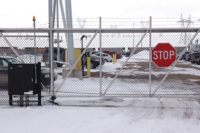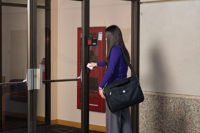In a world dominated by high-tech talk like IoT, AI, cloud, mobile credentials, etc., it can be easy to overlook the fact that one of the original electronic access control technologies — the keypad — is not only still relevant today, but could be the best fit for certain applications.
In fact, whether used as a stand-alone entry-level option or fully integrated into a complex enterprise-wide access control system, keypads have a place at nearly every level of security.
“Today’s keypads function as part of a connected system that uniquely combines multiple technologies into a single solution,” says Russ Anderson, technical product trainer, ASSA ABLOY Electromechanical Specialties, ASSA ABLOY, New Haven, Conn. “Keypads can also be used to secure a greater number of openings, such as closets, cabinets and restrooms. As organizations become increasingly aware of the costs of re-keying, we expect to see continued transitioning from mechanical locks to keypads, which reduce costs and can be integrated into an access control software system.”
It is increasingly common to see keypads in non-traditional places, as well as being an important part of an overall access control system.
“Keypads are used in conjunction with a card, biometric or other form of credential,” says Brad Aikin, channel led business leader, security integrators, Allegion, Carmel, Ind. “Access control keypads provide a dual authentication security enhancement, particularly when combined with traditional card reader applications.”
Aikin adds that keypads are a good way for security integrators to add security and functionality to a customer’s environment. “In dialogue with end users regarding how they wish to utilize their environment and corresponding application needs, consider how keypads could be used to improve the convenience of existing applications that are mechanical-only or enhance the security of electronic applications that are card-only.”
Keypad technology is far from stagnant and some of the newest developments involve Bluetooth, wireless and networking technologies. These result in features that make them both easier to install and more valuable.
Common Misconceptions About Keypads
Keypads are hard to install, and are less secure than other technologies. True or False?
False, says ASSA ABLOY’s Russ Anderson. “Common misconceptions are that keypads are expensive, are not secure enough, or are too difficult to install for non-locksmiths. Really, it all comes down to the product. There are keypads on the market for every need and price point. There are also keypads with 10-digit code capabilities … which make entry codes stronger and harder to duplicate. And finally, many of today’s products require minimal work to install and come with step-by-step video instructions on the best way to install keypad locks in different locations.”
Another misconception some security integrators may have about keypads is that they are more easily circumvented by getting to the back of the keypad, says Alex Aaron of SECO-LARM Inc. “However, if the keypad is installed correctly with the tamper and other security measures connected, then they can be very secure.”
PIN codes are not necessarily inherently insecure, but they can be harder to control. This can be mitigated by using “rolling pins” with a finite life, says Allegion’s Brad Aikin. “While it requires additional management of codes, it can enhance their security.”
“Networked access control keypads provide the ability for any knowledgeable user to provide specific alerts or commands into the access control software from any location,” Aikin says. “This enables users to communicate specific events or needs through the keypad based on a designated code.”
Allegion’s Locknetics Narrow Stile Programmable Keypad can manage more than 1,000 user codes for two zones with options for doorbell alert, remote-release push button and door-position monitoring.
ASSA ABLOY’s Yale nexTouch merges data-on-card, wireless and standalone keypad technologies into a single platform, Anderson says. The wireless G100 with Aperio can be installed on glass.
“All of Yale’s solutions are designed for easy installation so we can facilitate our partners’ business growth while meeting their customers’ needs,” adds Rodger Schmidt, technical product trainer for ASSA ABLOY Electromechanical Specialties.
Some of the latest developments in keypads involve multiple relays and wireless options, says David Price, marketing manager, Camden Door Controls, Mississauga, Ontario. “Instead of just one relay, keypads today offer two relays, and those can be programmed to be activated by different users,” he says. “Battery-powered wireless keypads are readily available, affordable and offer up to four years of battery life.”
These two advancements are both advantageous to security dealers, he says. “Programmable relays allow dealers to segment keypad user permissions … Battery-powered wireless keypads allow installers to put a keypad wherever it is convenient for the building manager — without the time and expense of running wires.”
Some of the latest products will be Bluetooth-enabled, says Alex Aaron, technical sales, SECO-LARM USA Inc., Irvine Calif. “We’re working on a Bluetooth-enabled keypad that lets you program the keypad from the app.
“In the past keypads were limited to the number pad for inputting a code, and now you can use proximity cards, fingerprints and other biometric tags to unlock the door. The next big thing is app-based control of the keypad. You can assign hours and privilege levels to users and manage the keypads easier.”
There are keypads available for every price point and need, but what are some of the best applications for them today?
It is important to understand that not all keypads are right for all applications, Kaufman says. For example, if the keypad will be outside in harsh weather it should be ruggedized. But even if that is the case, they shouldn’t be limited to just that application.
“By understanding the environment and application, with proper selection, keypads can be used as intelligent standalone devices for smaller single-door applications where traditional credentials are not available, or as a supplement to traditional access control systems where the keypad is a better use case,” he says. “Know your application and understand the use case from the environment (internal/external) perspective and select the keypad best for that application.”
Some good applications for keypads include community pool gates and interior suite doors where convenience is preferred over mechanical keys, but the security of mobile credentials is not required, Aikin says.
Another issue is cost. “Keypads are the ideal choice when a facility has few staff members — because of the low equipment, installation and maintenance cost — or when there is high turnover, because it avoids paying for replacement cards,” Price adds.
Keypads are also being used in more non-traditional ways today.
“Keypads are being used to secure more than doors,” Aaron says. “We are seeing our keypads being used to secure machinery, heavy equipment, cabinets and drawers in medical facilities.”
ASSA ABLOY keypads can be used on glass, cabinets, drawers, and more, Anderson says. “To drive business growth it’s vital that dealers ask their customers detailed questions about the problems they need to solve, and then offer the right access solutions to overcome those problems. Staying up to date on the latest technologies and solutions allows dealers and integrators to offer innovative solutions that meet their customer’s unique challenges.”
Schmidt adds, “With so many options and technologies available today, understanding the richness of the market will help integrators offer the right solutions for their customer needs.”
More Online
For more on the topic of access control keypads visit SDM’s website, where you will find the following articles:
“The 21st Century Security Keypad”
www.SDMmag.com/the-21st-century-security-keypad
“The State of the Access Control Market in 2019”




